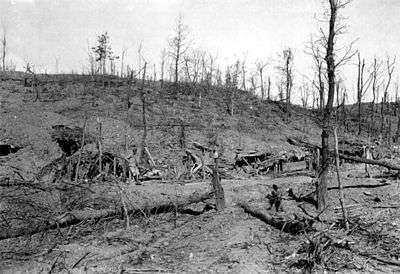Battle of Asiago
The Battle of Asiago (Battle of the Plateaux) or the Trentino Offensive (in Italian: Battaglia degli Altipiani), nicknamed Strafexpedition ("Punitive expedition")[3] by the Italians, was a major counteroffensive launched by the Austro-Hungarians on the Italian Front on 15 May 1916, during World War I. It was an unexpected attack that took place near Asiago in the province of Vicenza (now in northeast Italy, then on the Italian side of the border between the Kingdom of Italy and Austria-Hungary) after the Fifth Battle of the Isonzo (March 1916).
| Battle of Asiago Strafexpedition | |||||||
|---|---|---|---|---|---|---|---|
| Part of the Italian Front (First World War) | |||||||
 The remaining alpine vegetation after the attack on Asiago. | |||||||
| |||||||
| Belligerents | |||||||
|
|
| ||||||
| Commanders and leaders | |||||||
|
|
| ||||||
| Units involved | |||||||
|
|
| ||||||
| Strength | |||||||
|
172 battalions 850 guns |
300 battalions 2,000 guns | ||||||
| Casualties and losses | |||||||
|
15.453 Killed 76.642 Wounded 55.635 Missing or Captured[1] |
10.203 Killed 45.651 Wounded 26.961 Missing or Captured[2] | ||||||
Commemorating this battle and the soldiers killed in World War I is the Asiago War Memorial.[4]
Background
Already for some time the Austrian commander-in-chief, General Conrad von Hötzendorf, had been proposing the idea of a Strafexpedition that would lethally cripple Italy, Austria-Hungary's ex-ally, claimed to be guilty of betraying the Triple Alliance, and in previous years he had had the frontier studied in order to formulate studies with regard to a possible invasion.
The problem had appeared to be serious, mostly because the frontier ran through high mountains and the limited Italian advances of 1915 had worsened the situation and excluded a great advance beyond the valleys of Valsugana and Val Lagarina (both connected by railway) and the plateaus of Lavarone, Folgaria and Asiago.
The geographic location of the routes of advance was conducive to the original plan which called for an advance from Trent to Venice, isolating the Italian 2nd and 3rd Armies who were fighting on the Isonzo and the Italian 4th Army who was defending the Belluno region and the eastern Trentino.
The preparations for the battle began in December 1915, when Conrad von Hötzendorf proposed to his German counterpart, General Erich von Falkenhayn, shifting divisions from the Eastern Front in Galicia to the Tyrol, substituting them with German divisions. His request was denied because Germany was not yet at war with Italy (which would declare war on Germany three months later), and because redeploying German units on the Italian Front would have diminished German offensive capability against Russia. After having received a negative reply from the Germans, who refused the proposed replacement and actively tried to discourage the Austro-Hungarian proposed attack, Conrad von Hötzendorf decided to operate autonomously. The 11th Austro-Hungarian Army, under the command of Count Viktor Dankl, would carry out the offensive followed by the 3rd Army under Hermann Kövess. It was not so easy, however, because the Italians had deployed in the area about 250,000 troops (General Brusati's First Army and part of the Fourth Army). Italian intelligence had been gathering information about an impending enemy offensive in Trentino — and a big one — for about a month, but Cadorna dismissed those reports, persuaded as he was that nothing could happen in that region.
Battle
On 15 May 1916, 2,000 Austrian artillery guns opened a heavy barrage against the Italian lines, setting Trentino afire. The Austrian infantry attacked along a 50 km front. The Italian wings stood their ground, but the center yielded, and the Austrians broke through, threatening to reach the beginning of the Venetian plain. With Vicenza about 30 km away, all the Italian forces on the Isonzo would face outflanking.
Cadorna hastily sent reinforcements to the First Army, and deployed the newly formed Fifth Army under Pietro Frugoni to engage the enemy in case they succeeded in entering the plain. The situation was critical, but the commitment of reserves and the replacement of several Italian commanders who were judged unfit gradually improved the situation. The new Italian defensive line on Mounts Pasubio, Novegno, Zugna, Buole Pass and Astico Valley held and repelled repeated Austro-Hungarian attacks; on 2 June, Italian troops started their counteroffensive, slowly regaining ground.
Furthermore, on 4 June, the Russians unexpectedly took the initiative in Galicia, where they managed to enter Austrian soil. Although they were effectively countered by German and Austro-Hungarian troops, Hötzendorf was forced quickly to withdraw half of his divisions from Trentino. With that, the Strafexpedition could no longer be sustained and the Austrians retired from many of their positions. Italian troops in the region were increased to 400,000 to counter the Austrian positions.
Although the Strafexpedition had been checked, it had political consequences in Italy: the Salandra Cabinet fell, and Paolo Boselli became the new Prime Minister.
Bibliography
- Enrico Acerbi, Strafexpedition, Gino Rossato Editore, 1992
- Gerhard Artl: Die "Strafexpedition": Österreich-Ungarns Südtiroloffensive 1916. Verlag A. Weger, Brixen 2015, ISBN 978-88-6563-127-0.
- Fritz Weber: Alpenkrieg. Artur Kollitsch Verlag, Klagenfurt 1939.
- Walter Schaumann: Dall'Ortles all'Adriatico Immagini del fronte italo-austriaco 1915–1918. Wien 1993.
- L'esercito italiano nella grande guerra LEINGG (1915–1918) Volume I – IV /Ministero della Guerra – Ufficio Storico, Roma 1929–1974.
References
- Data for the period 15 May - 31 July 1916, from the diary of the First Army, in: Gianni Pieropan, 1916. Le montagne scottano, Tamari editori, Bologna, 1968, p. 214.
- Numbers for the period 15 May - 31 July 1916, from Austrian official reports, in: Gianni Pieropan, 1916. Le montagne scottano, Tamari editori, Bologna, 1968, p. 214.
- Thompson, Mark (2008). The White War: Life and Death on the Italian Front, 1915-1919. London: Faber and Faber, p. 163.
- "Sacrario militare di Asiago-Leiten e museo del Sacrario" (in Italian). Itinerari della Grande Guerra. Retrieved 24 April 2013.